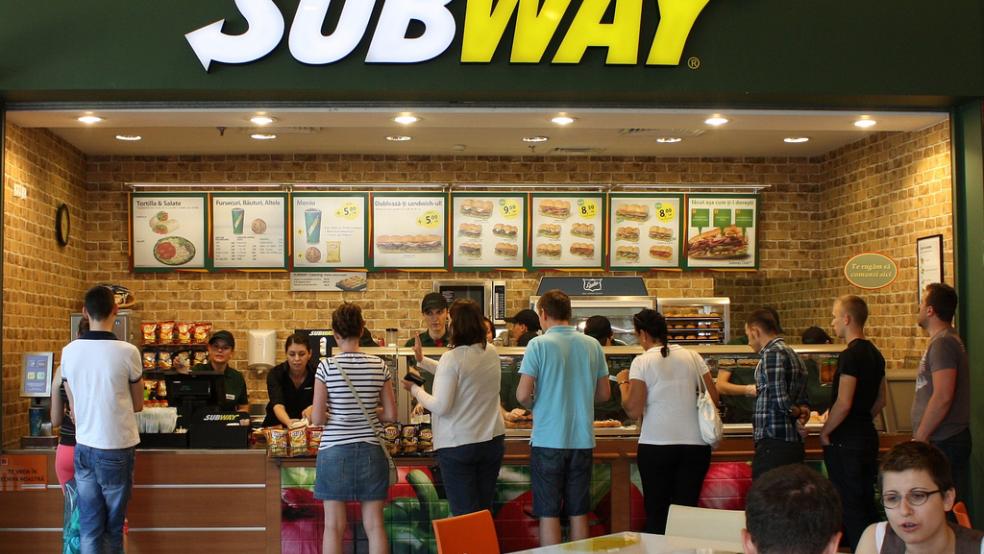While visiting her parents recently, Alex dropped off a large shopping bag full of processed food, explaining that she and her fiancé were giving up anything containing chemicals, preservatives, refined sugar and anything low fat or sugar free.
“Our peanut butter now has one ingredient,” she said.
Worried about the unknown long-term effects of processed food, Alex decided it was better to eat what is being called “clean food.” She cited concerns about her future health and the health of her children if she were to get pregnant as the primary reasons for the change. “If I can’t pronounce or define the ingredients on the back of the box, I won’t buy it.”
Related: Here’s Why Your Breakfast Just Got Way More Expensive
Alex isn’t alone. More and more Americans are questioning what they’re putting into their bodies and what the effects of it could be. (As a sign of that, Google this month announced it would integrate nutrition details like calories and carbs for fast food items into its search results on its mobile app.) Packaged food makers and restaurants — especially fast food ones — are being forced to respond if they don’t want to continue losing billions of dollars in market share.
In a steady, almost daily drumbeat of announcements, large packaged food manufacturers and restaurant chains have been touting changes to the ingredients they use and the food they produce.
Papa John’s International, which promises “Better Ingredients. Better Pizza” in its advertising, is reportedly spending $100 million a year to cut artificial ingredients, corn syrup and preservatives from its menu. General Mills, maker of the popular breakfast cereals Trix, Reese’s Puffs, and Lucky Charms, said it plans to remove artificial colors and flavors from those and all its other cereals by 2017.
“With our consumers, it reached a tipping point in the last couple of years with the trend toward simpler food,” Jim Murphy, president of the General Mills cereal division, said in a post on the company’s blog. “I remember the meeting where we all looked at each other and said ‘We’re just done with these, we’re going to do the whole line.’”
The list of changes goes on and on and on. Subway said it would replace all artificial colors, flavors and preservatives with natural equivalents over the next 18 months. Chocolate giant Hershey pledged to remove GMOs and use simple ingredients. Struggling McDonald’s swapped out soda on its kid’s menu in favor of milk.
Slideshow: 16 Companies Taking Some ‘Junk’ Out of Their Food
“There’s a food movement toward healthier and more environmentally friendly eating, and it’s growing stronger every day,” says Marion Nestle, an NYU professor of nutrition and food studies and author of several award-winning books on food politics.
Nestle credits the beginning of the movement to Eric Schlosser’s Fast Food Nation, published in 2001, and Michael Pollan’s Omnivore’s Dilemma, published two years later. Schlosser’s book focuses on the evolution of the local and global influence of the U.S. food industry.
Eating out and ordering in are staples of American culture. While Americans want to eat healthier, they don’t want to give up their favorite foods. “They’re looking for restaurants to deliver,” says registered dietitian and nutritionist Isabel Maples. “They don’t want to give up going to a restaurant, they want restaurants to meet their demands.” And restaurants have started to cave.
Women are the main drivers for healthy choices at fast food restaurants, not only because they want healthy options for themselves, but also for their children. According to a Technomic poll, 74 percent of women say it’s important for restaurants to offer consumers healthy choices.
Even with these new changes at fast food chains and packaged food makers, it’s unclear how much impact they’ll have on Americans. “The changes bring attention to how little we know about the health effects of commonly used additives and to the overall harm of diets based largely on food products rather than food,” says Nestle.
Related: The 17 Best Supermarkets in America
Due to a 57-year-old law, companies are able to add thousands of ingredients to food without informing the Food and Drug Administration (FDA). The FDA allows companies to term food additives as “generally recognized as safe” and doesn’t require them to be subjected to screening. The law was put into place to help manufacturers of common ingredients, such as vinegar and table salt, bypass the extensive FDA safety-review process. Other companies have been using this loophole to get their products on the shelves as quickly as possible, according to a report from The Center for Public Integrity.
Now that consumers are starting to question the unpronounceable elements of the food they’re eating, companies are scrambling to whittle down the number of ingredients in their food and switch unknown ingredients for common ones.
Fast food chains also want to change the popular notion that their food is synonymous with unhealthiness. Childhood obesity and fast food are routinely mentioned in the same sentence. Rumors circulate about what the burgers or chicken nuggets at McDonald’s are really made out of — everyone’s seen the YouTube videos, which McDonald’s has since discredited, but the public still wonders.
This spreading skepticism has put fast food restaurants in a bind. In the past, a fast food chain would lose money on a healthier menu option because it wasn’t profitable. Since nobody was purchasing the healthy food, the restaurant would remove it from the menu. But then critics would have more to complain about. Now that these items are becoming more popular, restaurants may be able to offer them without worrying about the bottom line.
Nestle believes the recent announcements aren’t enough. She finds that the major issues in nutrition revolve around too many calories, too little fiber, and the use of antibiotics and hormones in farm animal and poultry production. “Taking out the colors and leaving in the sugar doesn’t change much,” Nestle says.
Even General Mills acknowledges that getting rid of additives will mean “minimal to no changes in nutrition,” General Mills senior marketing manager Lauren Pradhan told The Washington Post.
While big food companies and fast food chains are responding to customer demand, it’s questionable whether the changes they’re making will actually lead to much healthier food.
Top Reads from The Fiscal Times:


